The science of ocean bioluminescence
Interview with
Edith - In fact in the open ocean environment most of the animals make light. You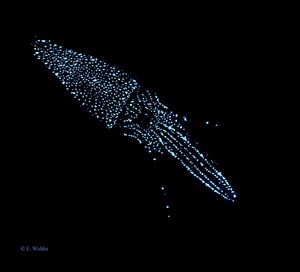 drag a net out there and most of the animals you bring up are producing light and in some cases 80-90% of the animals. And it's fish, shrimp, squid, jellyfish, and they use it to help them survive. They use it to help them find food, to attract mates, and to defend against predators in all kinds of amazing and bizarre ways.
drag a net out there and most of the animals you bring up are producing light and in some cases 80-90% of the animals. And it's fish, shrimp, squid, jellyfish, and they use it to help them survive. They use it to help them find food, to attract mates, and to defend against predators in all kinds of amazing and bizarre ways.
So for finding food you have things like the luminescent lures or built in flashlights to help them see in the dark. For finding mates they can flash certain species-specific patterns or have light organs that are shaped in a unique fashion that allows one species to identify another.
And then for defence there's just a huge range of different ways of using bioluminescence. For example, quite a few animals can release their bioluminescent chemicals into the water just the way a squid or an octopus release an ink cloud. These animals will release their light into the face of a predator, temporarily blinding the predator while they swim away into the darkness.
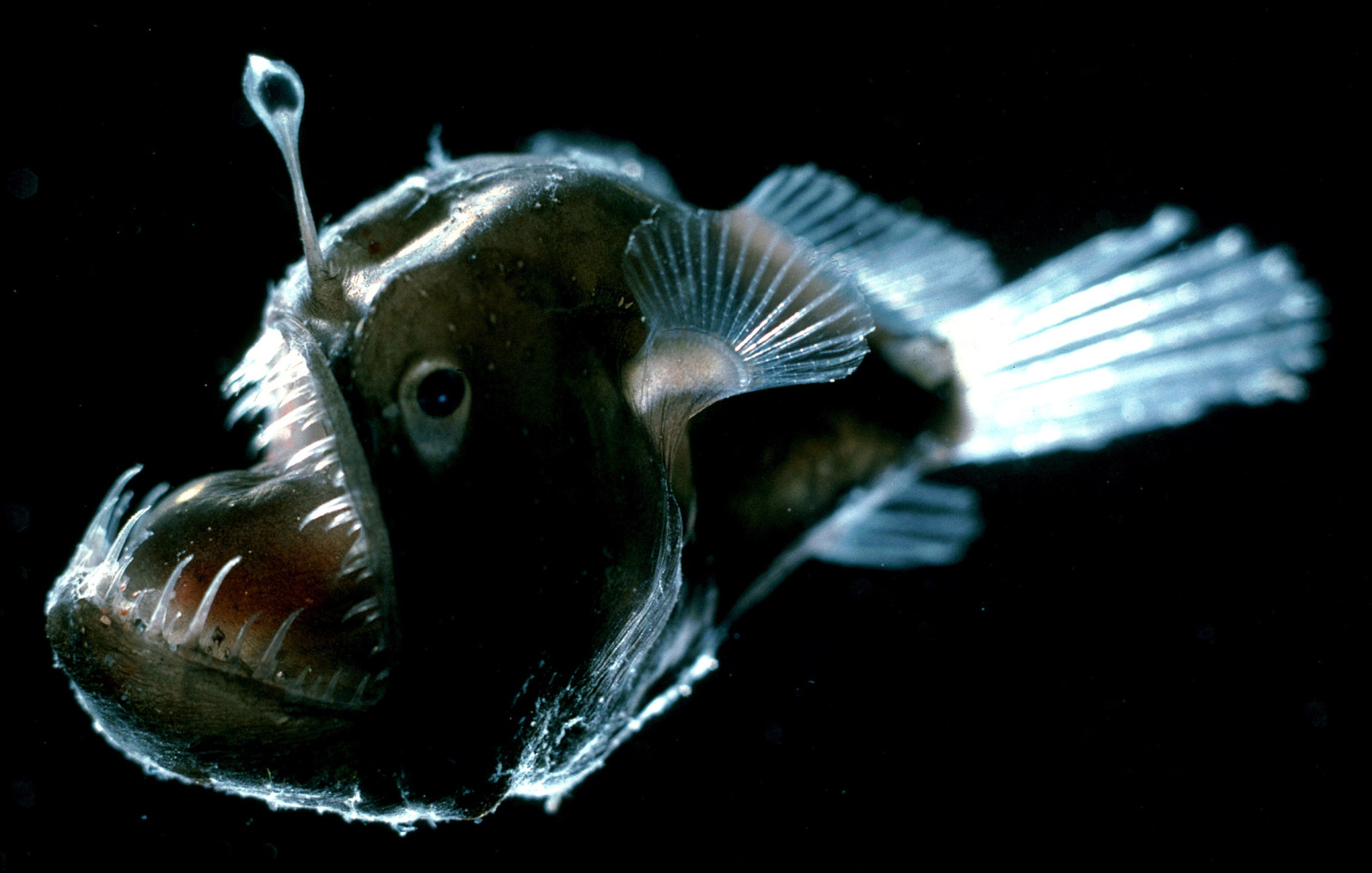 Helen - So there are all sorts things marine animals do with their homemade light- but how do they make it in the first place?
Helen - So there are all sorts things marine animals do with their homemade light- but how do they make it in the first place?
Essentially it comes down to a reaction between a substrate and an enzyme - generically referred to as luciferin and luciferaze - but, it's not as simple as that.
Edie - We think bioluminescence has evolved maybe 40 separate times, maybe as many as 50 separate times. It's a really unusual example of convergent evolution because there are very different chemistries in different animals. Some animals use the same chemistries and it's even across species and across phyla. But they're extremely different depending on different cofactors and different enzymes and different substrates. It's just very unusual in that respect.
For most of these animals they're making the chemicals that produce light out of the food that they eat. And usually some derivation of amino acids, enzymes or proteins. They hold these chemicals usually in cells in their bodies and when they want to make light there's some activator usually a nerve action potential that triggers the release of something, maybe calcium or hydrogen, that's the missing element that then allows the light reaction to occur.
Some animals get their light form bioluminescent bacteria. So they have a symbiotic relationship with the bacteria. But the fish sometimes need to turn that light off and so they'll often have mechanical shutters that can close down around the light in some fish the light organ actually rotates back into the head just light the headlights on your Lamborghini.
Helen - Edie has spent a lot of time miles down beneath the waves, studying the glowing creatures of the depths, and she told me about the first time she went down in a submersible. Up until this point she'd only been conducting her research on bioluminescent organisms in the lab.
 Edie - I went down to 880 feet, it was an evening dive, I turned out the lights and I was just blown away by the amount of light a saw. The bioluminescence light show was breathtakingly beautiful, but I also knew enough about it at this point to know how energetically costly it was to produce this light. And I thought, this has got to be one of the most important processes in the ocean, I couldn't understand why more people weren't studying it. And it completely changed the course of my career.
Edie - I went down to 880 feet, it was an evening dive, I turned out the lights and I was just blown away by the amount of light a saw. The bioluminescence light show was breathtakingly beautiful, but I also knew enough about it at this point to know how energetically costly it was to produce this light. And I thought, this has got to be one of the most important processes in the ocean, I couldn't understand why more people weren't studying it. And it completely changed the course of my career.
So, a lot of the reason I came to understand that it wasn't being studied more is there weren't tools available for studying it. Clearly you have to do a little bit more than go down and say, 'Oh wow everything glows!'. And so I started working with engineers to develop instruments that could better quantify bioluminescence in the ocean. I also doing more work from submersibles and eventually developed a technique that uses video image analysis to identify the animals by the type of flashes they produce. And it's turned out to be a very powerful tool for mapping the 3D distribution patterns of animals in the ocean.
Helen - Even with the advancing technologies for venturing into the depths in person, Edie began to think about what she was missing.
Edie - Of the 100s of dives I've made in submersible I've always felt like how much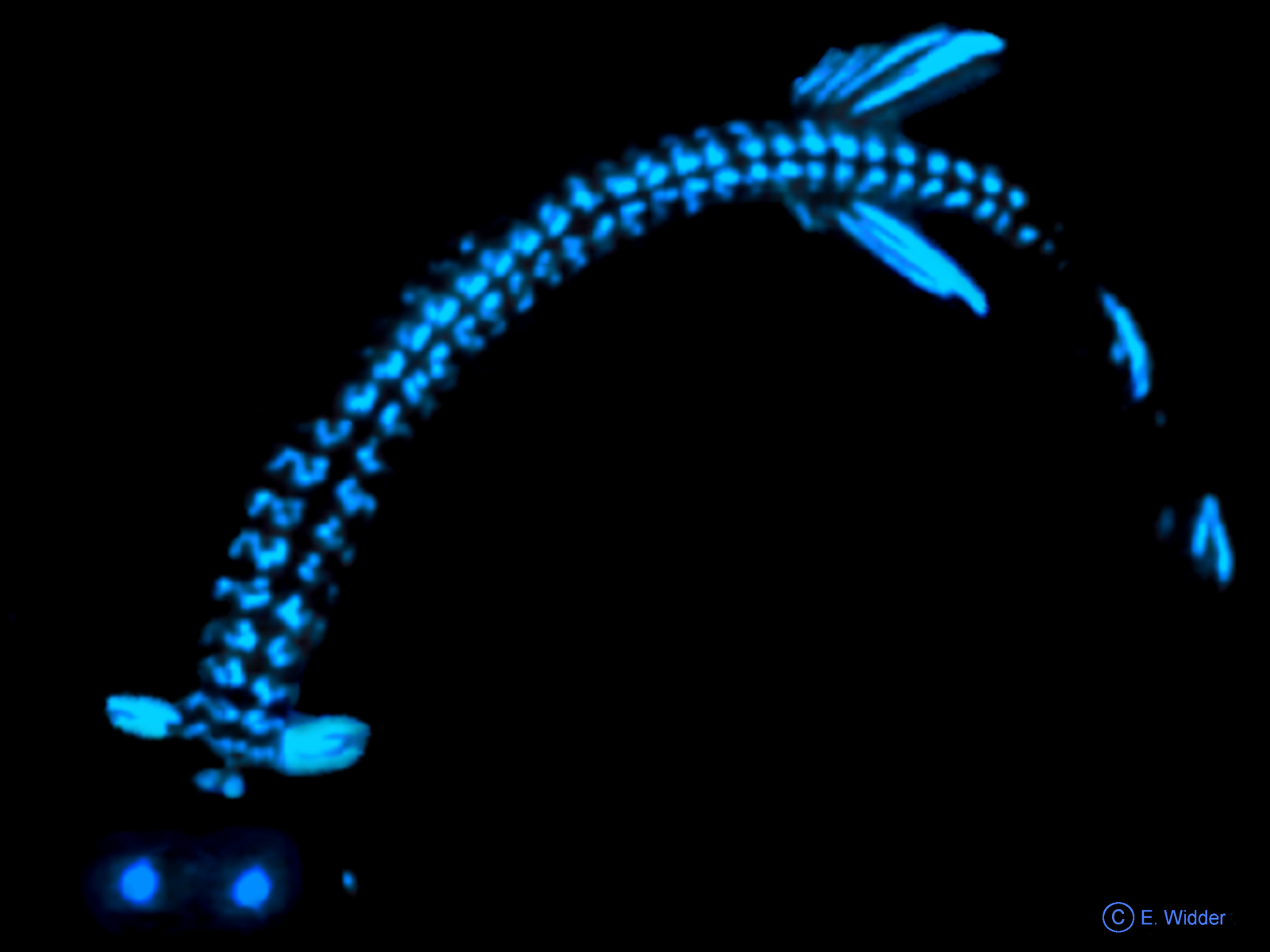 is there out there that I'm not seeing because we're scaring it away with our bright lights and noisy thrusters.
is there out there that I'm not seeing because we're scaring it away with our bright lights and noisy thrusters.
And so I wanted to develop a camera that could be left quietly on the bottom of the ocean that was battery powered but unlike cameras that had been used in the past I wanted it to be completely unobtrusive. So I used red light, sort of the way people studying nocturnal animals use infra red light on land, trouble is you can't use infra red in the ocean because its absorbed so quickly in the water. So we used far red light and then a camera that was super sensitive to compensate for the fact that so much of that light is absorbed.
And so now we've started to study these animals in their natural habitat. I also developed an optical lure that imitates certain bioluminescent displays. That's proved very valuable in working out this language of light and what kind of displays different animals respond to.
Helen - As well as learning about the fascinating lives of glittering deep ocean species, Edie has also started applying her bioluminescence research to helping solve some of the problems facing the oceans.
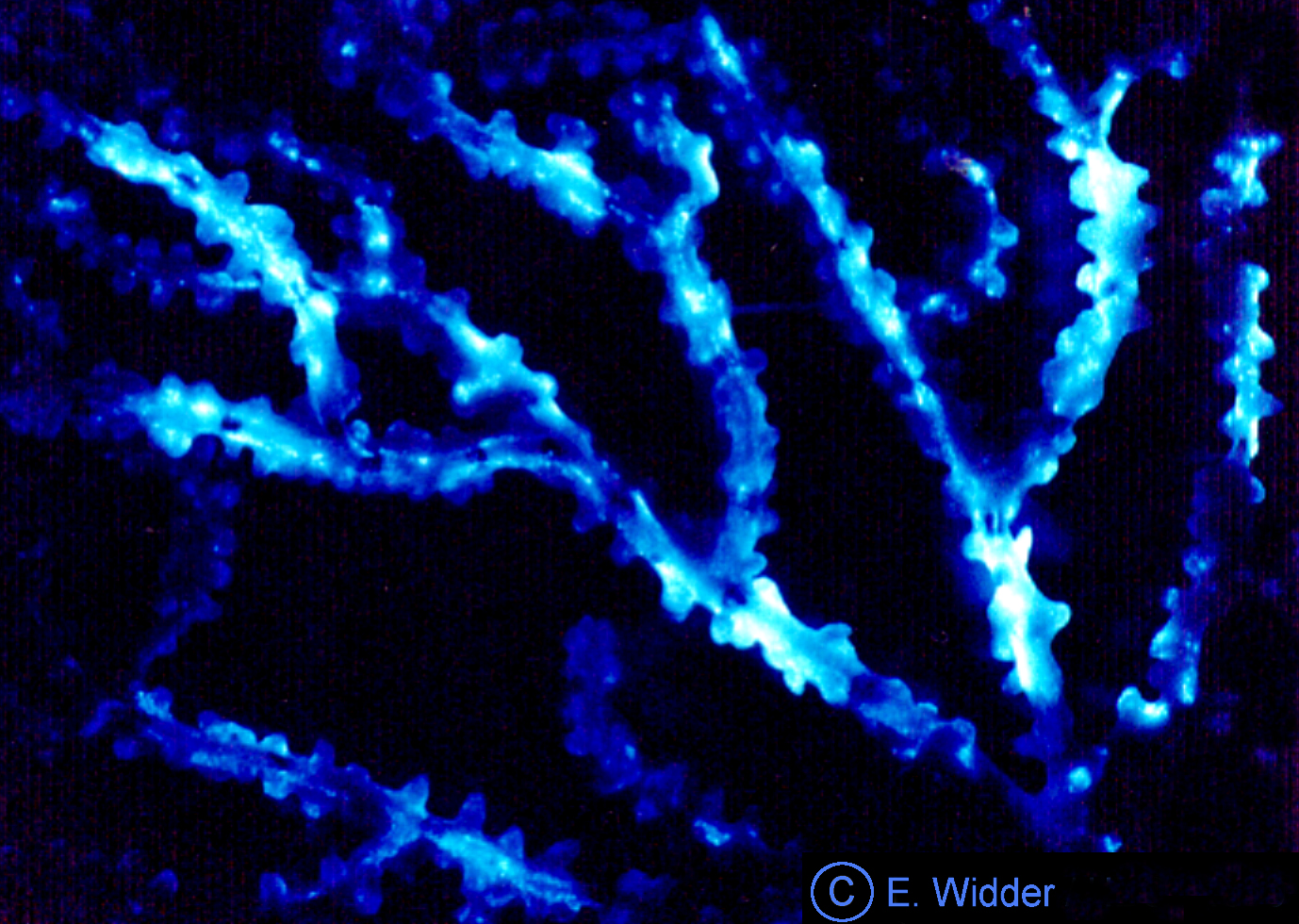 Edie - One of the big ones is tracking pollution. We have a lot of problem with non point-source pollution which is things like fertiliser and pesticides running off crop land, animals waste out of animal feed lots, toxic cocktails of hydrocarbons that run off our roads every time we have a rain storm. Just all kinds of things that are running off the land and having a very profound effect on coastal ecosystems.
Edie - One of the big ones is tracking pollution. We have a lot of problem with non point-source pollution which is things like fertiliser and pesticides running off crop land, animals waste out of animal feed lots, toxic cocktails of hydrocarbons that run off our roads every time we have a rain storm. Just all kinds of things that are running off the land and having a very profound effect on coastal ecosystems.
And so I felt like what we really want to do here is make pollution visible. So we're actually using bioluminescence to do that. We use bacterial bioluminescence.
The reason bacteria glow all the time is that the bioluminescence is linked to the respiratory chain - so the breathing of the bacteria. And any pollutant that interferes with that, dims the light.
So the bioluminescent bacteria are akin to a canary in a coalmine. Miners used to take a canary down with them before they had sensors that could detect the poisonous gases that they had to be concerned about. They knew when the canary stopped singing or keeled over that they better get out of there very quickly. And that's what's known as a broad-spectrum bioassay. You're not measuring for a specific pollutant but a whole range of them. And that's what the bacteria do for us.
So we take sediment samples. When you're talking about water pollution most of 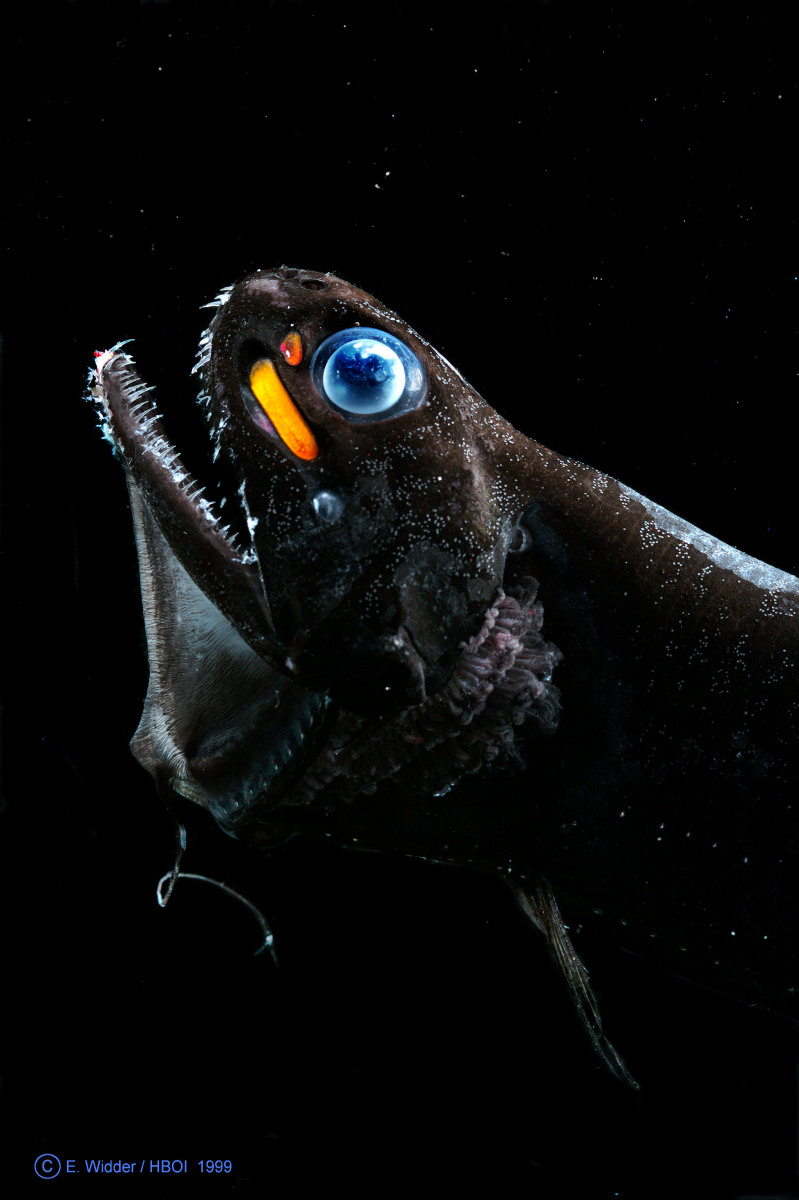 the water pollution actually resides in sediments. So we take sediments and test the bacteria against these sediments and figure out where the toxins are accumulating in the environment.
the water pollution actually resides in sediments. So we take sediments and test the bacteria against these sediments and figure out where the toxins are accumulating in the environment.
And then we've also developed a water quality monitoring system called a Kilroy - because we hope these guys are going to be everywhere - that allows us to track the pollutant back to its source.
My dream is to get a pollution layer onto Google earth so that people can see the pollutants in their own back yards and in their favourite waterways and then work together to figure out what we can do to solve these problems.
Find out more:
ORCA (Ocean Research and Conservation Association)
Edith Widder
TED talk









Comments
Add a comment